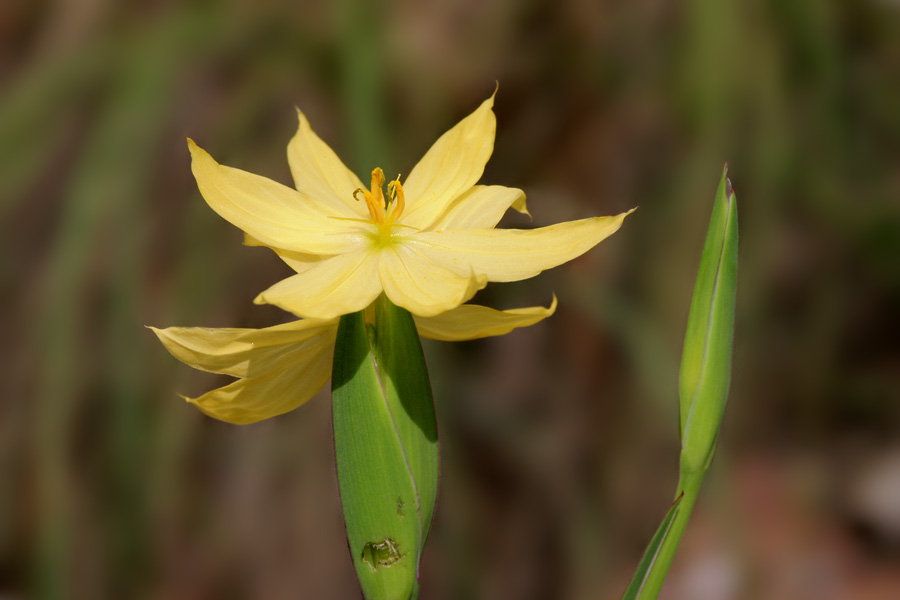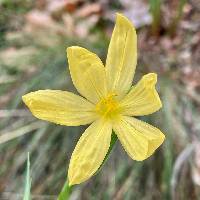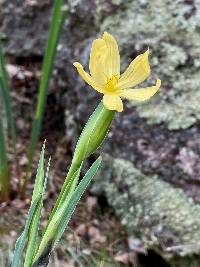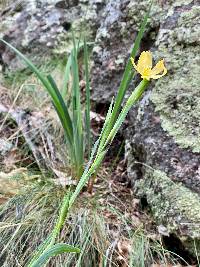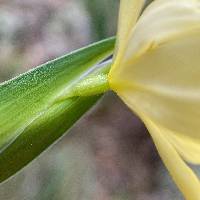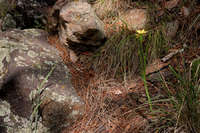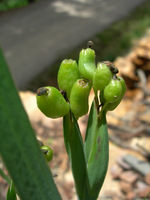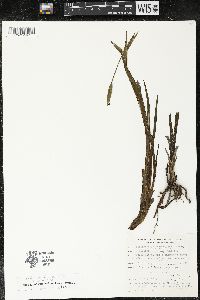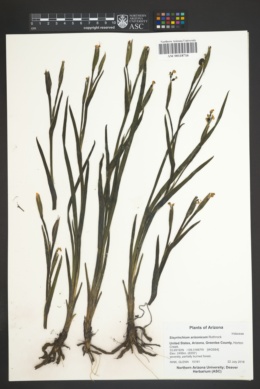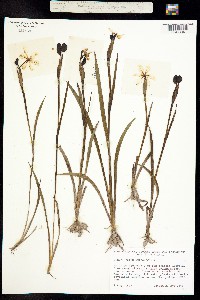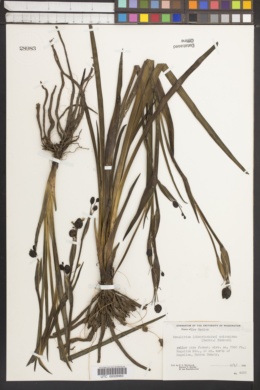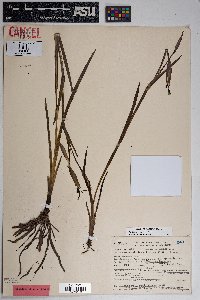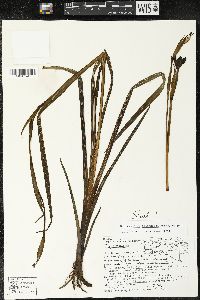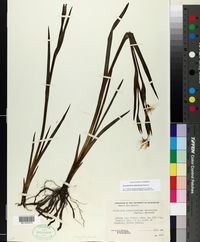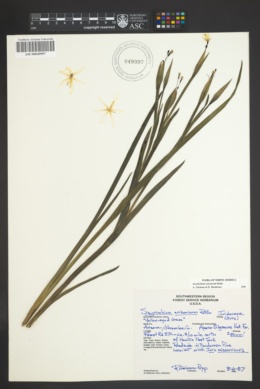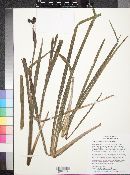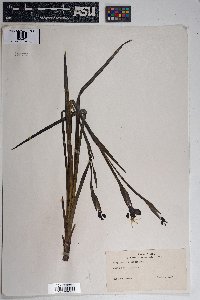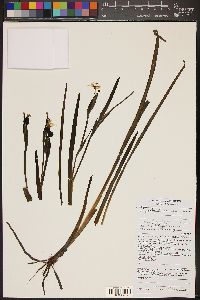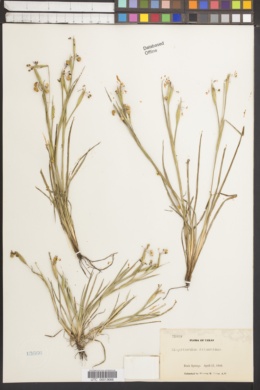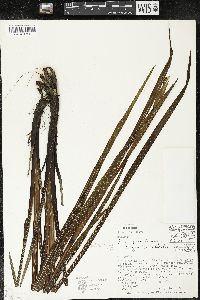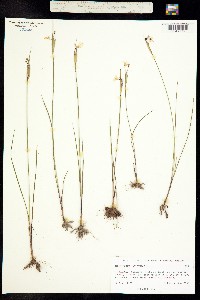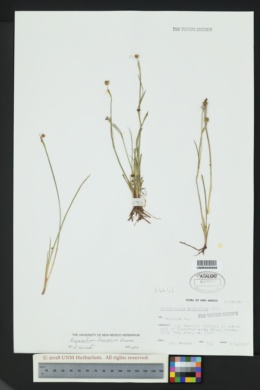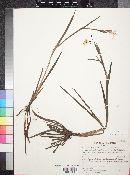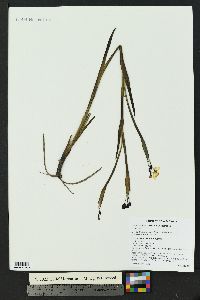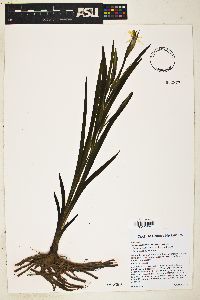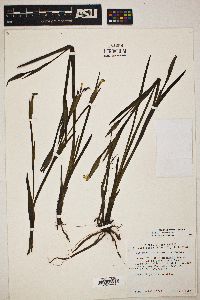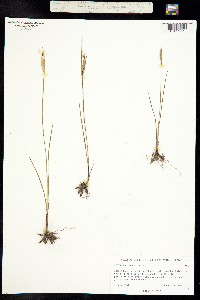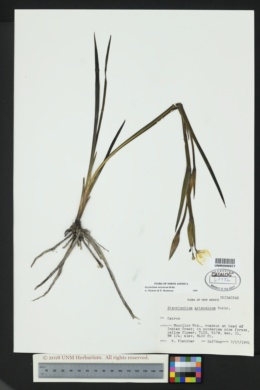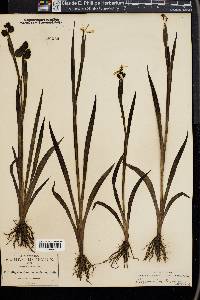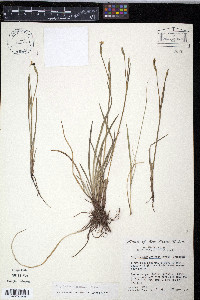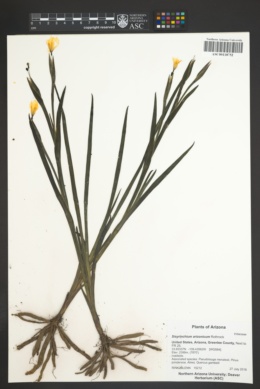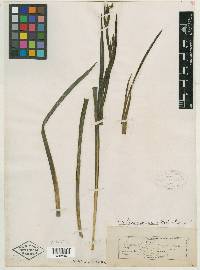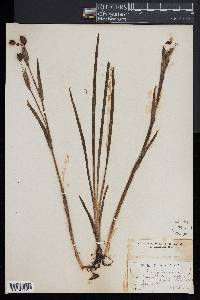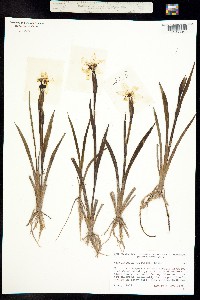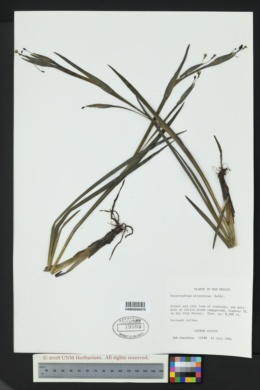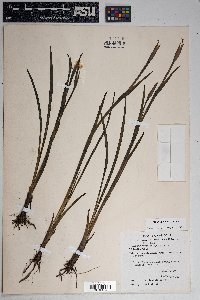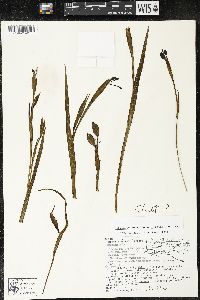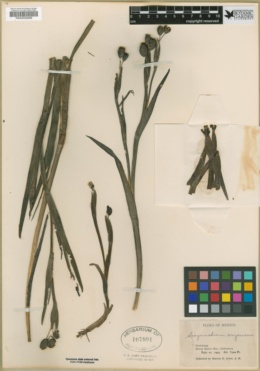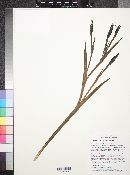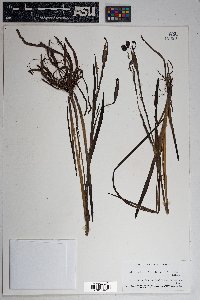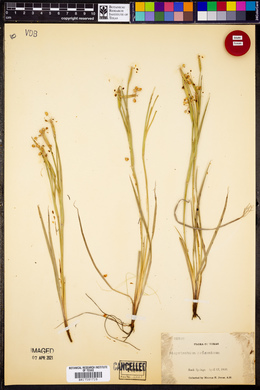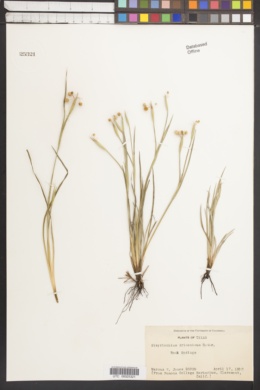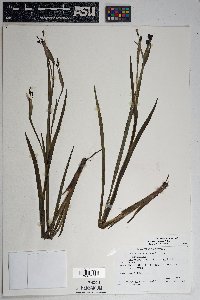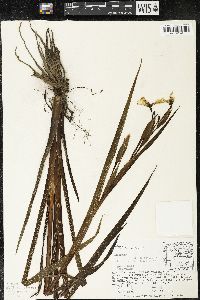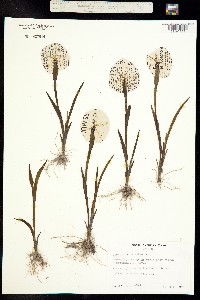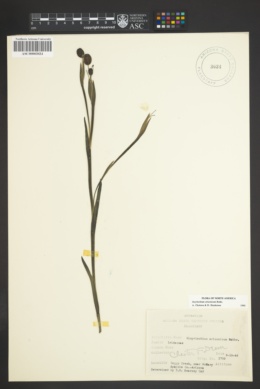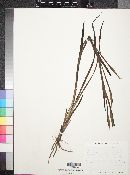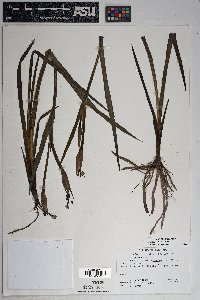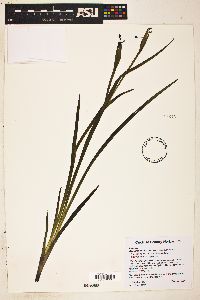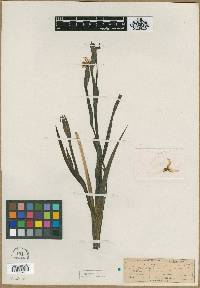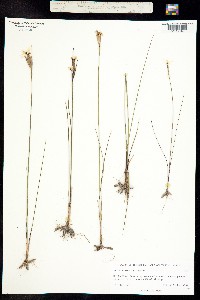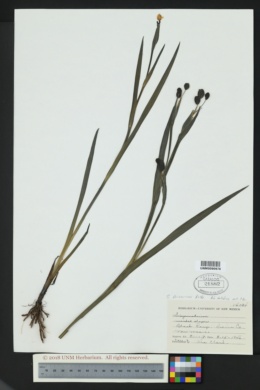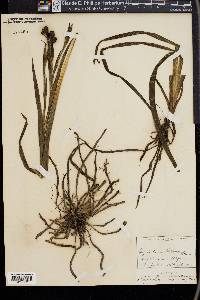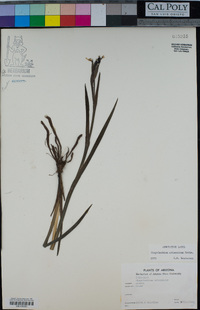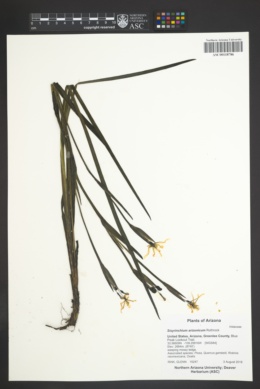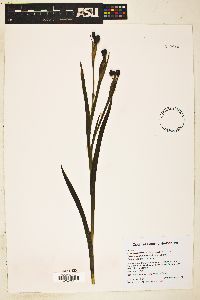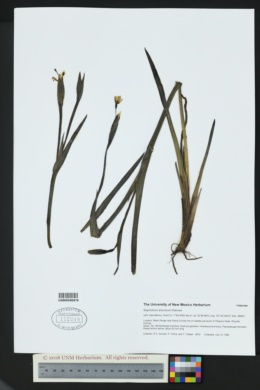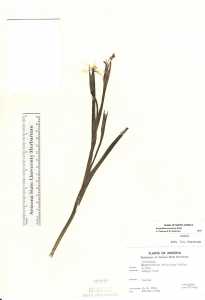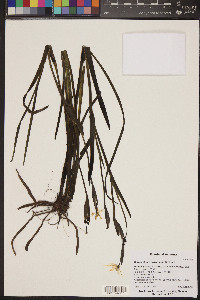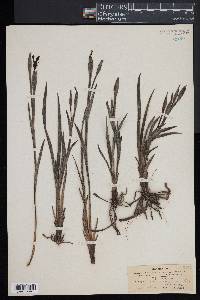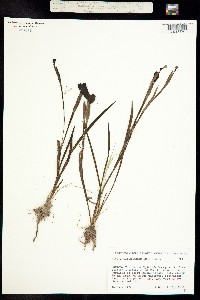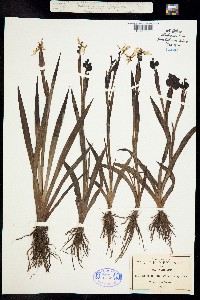Sisyrinchium arizonicum
|
|
|
|
Family: Iridaceae
Arizona blue-eyed grass, more...Arizona Blue-Eyed-Grass, Arizona blueeyed grass
[Oreolirion arizonicum (Rothrock) Bickn.] |
Herbs, perennial, cespitose, dark olive to blackish when dry, to 6 dm, not glaucous; roots conspicuously fleshy-thickened. Stems branched, with 2-4 nodes, 3.5-8 mm wide, glabrous to scabrous, margins denticulate at least apically, similar in color and texture to stem body; first internode 14-27 cm, shorter than leaves; distalmost node with 1-2 branches. Leaf blades glabrous to scabrous, bases not persistent in fibrous tufts. Inflorescences borne singly; spathes green, obviously wider than supporting branch, scabrous or glabrous, keels denticulate; outer 30-55 mm, equaling or to 3.7 mm longer than inner, tapering evenly towards apex, margins basally connate 5-6 mm; inner with keel evenly curved or abruptly gibbous, hyaline margins 0.3-0.8 mm wide, apex acuminate or rounded, ending just proximal to green apex. Flowers: tepals yellow to orange, usually with brownish veins; outer tepals 11-23 mm, apex rounded to acute, aristate; filaments connate only basally, base glabrous or occasionally stipitate-glandular; ovary similar in color to foliage. Capsules black or blackish brown, obovoid to turbinate, 8-19 mm; pedicel erect to ascending. Seeds globose, lacking depression, 1.5-2.2 mm, rugulose. 2n = 34, 36, 72. Flowering mid--late summer. Moist meadows, stream banks, open places in coniferous forest; 1600--3000 m; Ariz., N.Mex.; nw Mexico. Plant: perennial herb; erect to 60 cm tall; ROOTS conspicuously thickened Leaves: folded lengthwise in iris-like fashion but somewhat flexuous, mostly basal and distichous, the margins slightly hyaline basally; 5-12 mm wide INFLORESCENCE: an umbel with 2 spathe bracts, the lower (outer) bract enclosing the other (inner); SPATHE BRACTS with the dorsal keels denticulate at least apically; outer bract 30-55 mm long, tapering evenly to the apex, the margins connate basally (3)5-6 mm, the base sometimes minutely hirsute or scabrous on the surface; inner bract 27-51 mm long (sometimes longer than the outer), the hyaline margin narrow to wide, ending below or at the apex, the base tapering evenly (rarely abruptly curved) as it emerges from the outer bract Flowers: yellow to orange, generally with brownish veins; pedicels stiffly erect or ascending, glabrous, at anthesis shorter than or only slightly longer than the inner bract; tepals 11-23 mm long, the outer with obtuse or acute, apiculate apices; anthers 3-7 mm long; filaments united basally; ovary pubescent or glandular-pubescent Fruit: FRUITS a capsule, 8-19 mm long, obovoid to somewhat spherical, black or blackish brown. SEEDS 1.5-2.2 mm long, nearly spherical or angular, the surface reticulate Misc: Moist meadows, streamsides, and open places in coniferous woods:; 1600-2900 m (5300-9500 ft); Jul-Aug REFERENCES: Cholewa, Anita F. and Douglass M. Henderson. 1994. Iridaceae J. Ariz. - Nev. Acad. Sci. Volume 27(2), 215. Cholewa and Henderson 1993 Duration: Perennial Nativity: Native Lifeform: Forb/Herb General: Perennial with branched stems, erect to 60 cm tall, the roots conspicuously thickened, 2-4 nodes, the uppermost node with 2 peduncles, 3.5-8 mm wide including the wings, margins minutely dentate, surface minutely hirsute. Leaves: Equitant leaves 5-12 mm wide, mostly basal. Flowers: Spathe bracts with dorsal keel denticulate apically, the outer bract 30-55 mm long, margins connate basally, the inner bract 27-51 mm long, hyaline margin narrow to wide, ending below or at apex; flowers yellow to orange with brownish veins, pedicels stiffly erect to ascending, glabrous, tepals 11-23 mm long, outer with obtuse to acute or apiculate apices, anthers 3-7 mm long, filaments united basally, pubescent ovary. Fruits: Loculicidal capsule, 8-19 mm long, obovoid to somewhat spherical, black or blackish brown. Ecology: Found in moist meadows, along streams and mesic sites in coniferous woodlands from 5,000-9,500 ft (1524-2896 m); flowers July-August. Notes: Distinguished from the other species in the genus by the branched stems and the yellow to orange flower, the branched stem is key when comparing it to S. longipes and S. cernuum the other species with similarly colored flowers. Ethnobotany: Unknown Etymology: Sisyrinchium is from Greek sisyra for shaggy coat, because the corm tunics recall a shaggy coat, while arizonicum means of or from Arizona. Synonyms: Oreolirion arizonicum Editor: SBuckley, 2010 |

